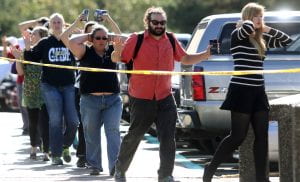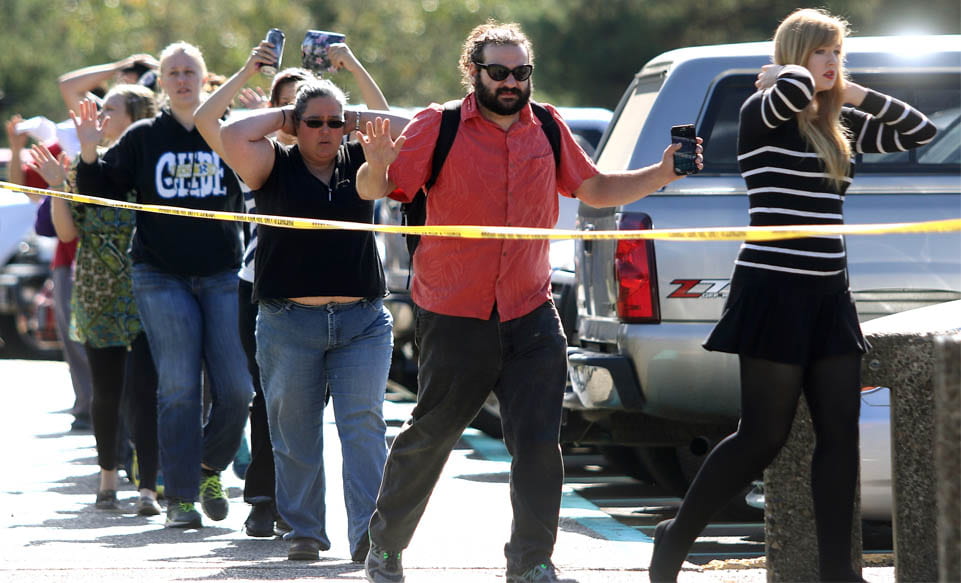BY RACHAEL BLANDAU – STAFF WRITER
Last week, yet another tragic shooting occurred at Umpqua Community College in Roseburg, Oregon, killing ten and injuring seven. The gunman, Christopher Harper-Mercer, was a student at the school, and targeted Christians. The attack ended with Harper-Mercer taking his own life.
This rhetoric is unfortunately becoming more and more common in the United States, with this shooting taking the number of school shootings this year up to 45. How can we stop these tragedies from occurring? Are we just doomed to sit by as the chaos continues? Until now, we have done just that as these incidents keep happening—professing our sorrow but not ever lifting a finger to change the story. We have yet to ban assault weapons, or put restrictions on them, even in the wake of this violence.
In 1996, a massacre in Tasmania left 35 dead, and Australia adopted strict gun laws, due to pleading from the Australian public. Since then, according to a study by Andrew Leigh of Australian National University and Christine Neill of Wilfrid Laurier University, the firearm homicide rate has fallen 59 percent. President Obama praised their gun laws after the Charleston Massacre in June, yet here we are several months later, and it has happened again.
So, what can we do to stop these tragedies from occurring? Many politicians and experts have weighed in, including some Presidential hopefuls that are looking for a new system to combat the violence. Democratic frontrunner Hillary Clinton announced on October 5th a new legislation for the regulation of guns.
“I’ve got no problem with people who are responsible gun owners, “ Clinton said. “There are millions of them…Let’s do everything we can to make sure the irresponsible and criminally and mentally ill don’t get guns.”
While Clinton makes a good point on the widespread availability of guns, she fails to see that mental illnesses are not the entire cause of these shootings. Many factors go into these attacks, such as race, gender, home situations, peer interaction, and, yes, mental illness.

Dr. Jeffery Swanson, a Psychology professor at Duke University weighed in on the psychiatry of mass shootings to CNN: “What I do know is that violent behavior—whether it’s serious violence or minor violence in populations—is never just one thing. It’s not a one thing problem. It’s going to be an accumulation of things, kind of a whole cocktail of factors.”
Unfortunately, one of the more frequent causes of mass shootings is copycat crimes. An angry young man that has been bullied for years might look at the story of James Holmes, the “Joker” shooter at the movie theater shooting of Aurora, Colorado, and applaud him for his carefully constructed plan. This spirals into another shooting that was modeled after the first, equally as devastating. This could be one of the main reasons why the contagion of killing sprees is spreading. An angry adolescent or a recently fired adult may look at the news and think that they could pull it off – that they could get their revenge. So, the violence spreads.
The statistics back it up—mass shootings are becoming more and more common. The news picks up a massacre one day and the next month another just like it follows. We are becoming desensitized to this violence. It has become a part of our cultural identity. Harvard and Northwestern conducted a study analyzing the frequency of these shootings. They concluded that since 2011, shootings have increased from one every six months, to one every two months. Adam Lankford, a criminal justice professor at the University of Alabama, calls it the “dark side of American exceptionalism.” It is hard not to agree when the United States has the highest number of mass shootings in the world, accounting for 31 percent in which at least four people are killed.
So, what can we do? Unfortunately, it is now impossible to completely eradicate these violent crimes. Now, we must settle for the next best option: decreasing their frequency and impact. Stricter gun laws, like those similar to vehicle registration would be a good start. So would a ban on assault rifles—weapons that have no use but to harm people. When Australia cracked down on guns, their firearm violence rate dropped exponentially. Though our problem is much larger, even a minor drop would be remarkable. The whole nation watched as innocents were slaughtered at Umpqua, and now is the time to stand up rather than stand by. We must put an end to this—or live with the consequences.
